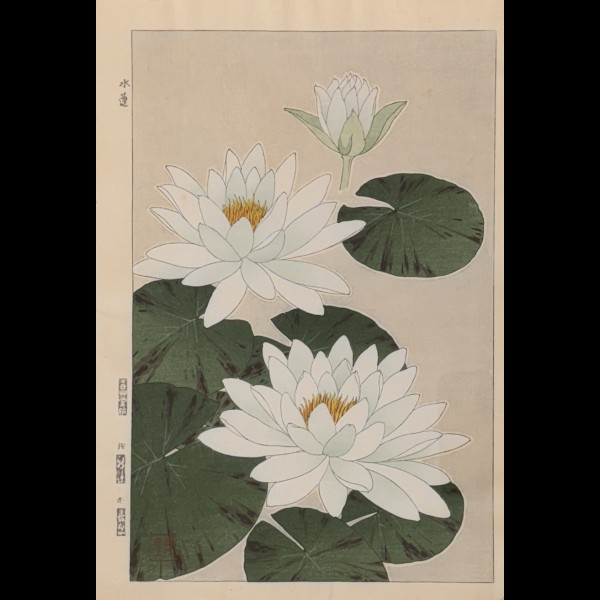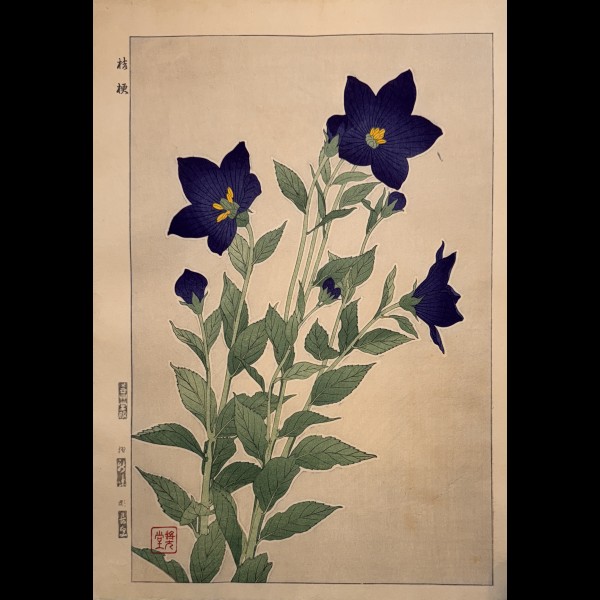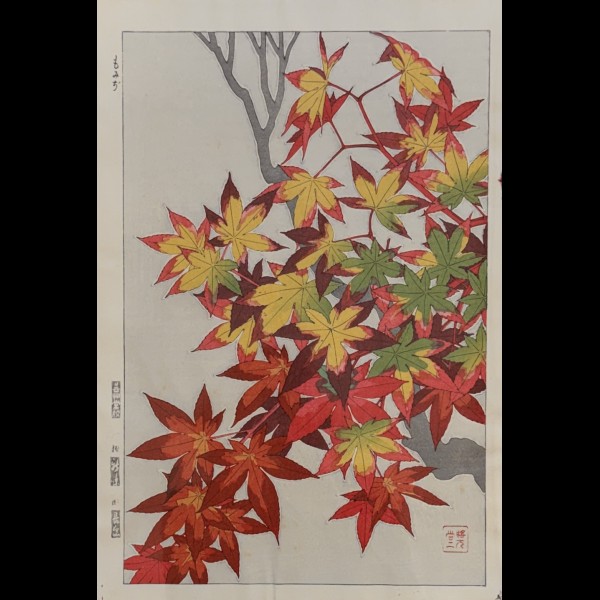SHODO KAWARAZAKI (1889-1973)
JUILLET : LOTUS, SUIREN
From a suite: Floral calendar of JapanCa. 1970Unsodo EditorNishiki-eShin hangaKachoeBeautiful colorsThe suiren literally means "sleeping lotus" because it opens at sunrise and closes at sunset. Since it opens at the hour of hitsuji (the hour of Aries), it is also called hitsuji-gusa. While it does grow wild in Japan, most cultivated varieties are of foreign origin, from India or Egypt...
380.00 €
SEPTEMBRE, CAMPANULE OU KIKYO
From a suite: Floral calendar of JapanCa. 1970Unsodo EditorNishiki-eShin hangaKachoeBeautiful colors, some tiny foxingTHE KIKYO is a celebrated autumn flower, being counted as one of the seven representative autumn flowers under the name of Asagao. As a matter of fact, however, it begins to bloom in summer and comes to its end at the beginning of autumn. Its flower is campanulate and five-serrated. Though it is generally deep purple, yet it is sometimes white, especially when the plant is cultivated.• Of the cultivated kinds, the most well-known are Hina-kikyo, Sawa-kikyo, Iwa-kikyo and Chishima-kikyo. And these cultivated ones, thanks to quick culture, appear on the market about May and June...
300.00 €
OCTOBRE : ERABLE, MOMIJI
From a suite: Floral calendar of JapanCa. 1970Unsodo EditorNishiki-eShin hangaKachoeBeautiful colorsThe word "momiji" originally meant "purple foliage." Among red-leaved maples, the kaede, being the most beautiful and widespread, eventually acquired the name "momiji." It is a deciduous tree that grows wild in fields and mountains. With its magnificent purple foliage, it produces small, dark red flowers around April and May. Planted in gardens, it has given rise to numerous cultivated varieties, including one called Iroha-kaede...
340.00 €
AOUT: HIMAWARI, TOURNESOL
From a suite: Floral calendar of JapanCa. 1970Unsodo EditorNishiki-eShin hangaKachoeBeautiful colors, some few foxingThe HIMAWARI is of Mexican origin.It was introduced to Japan long ago and now has many varieties.It blooms between August and September.Its name, Köjitsu-aoi, comes from the fact that it was long believed that the flower turned toward the sun...
350.00 €
JUIN : SHAKUYAKU
From a suite: Floral calendar of JapanCa. 1970Unsodo EditorNishiki-eShin hangaKachoeBeautiful colorsThe shakuyaku is a flower related to the peony. Although it thrives in China today, it originated in Northeast Asia. It was imported from China to Japan. Originally, it was cultivated as a medicinal plant. In spring, it develops a pretty bud and blooms around June...
380.00 €
OEILLETS
From a suite: Floral calendar of JapanCa. 1970Unsodo EditorNishiki-eShin hangaKachoeGood proof, beautiful colors, tiny scattered foxing...
280.00 €






